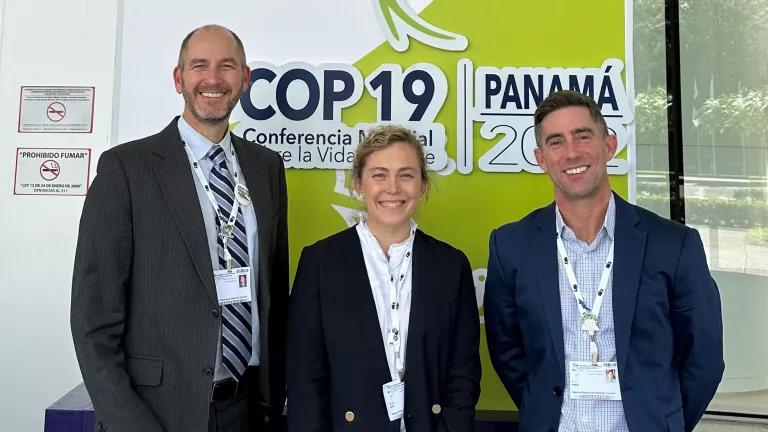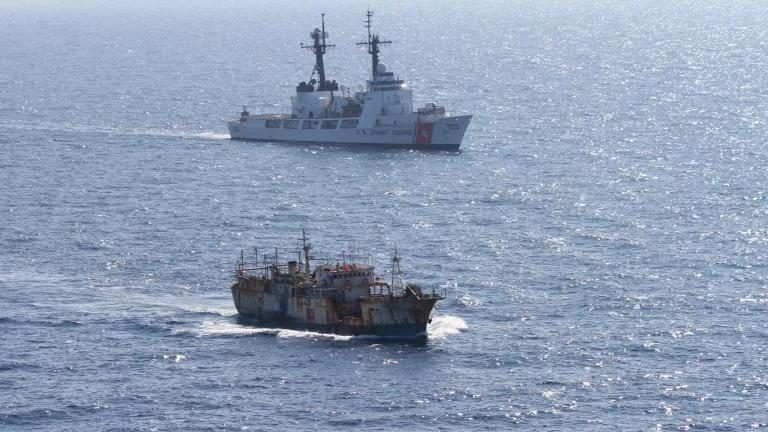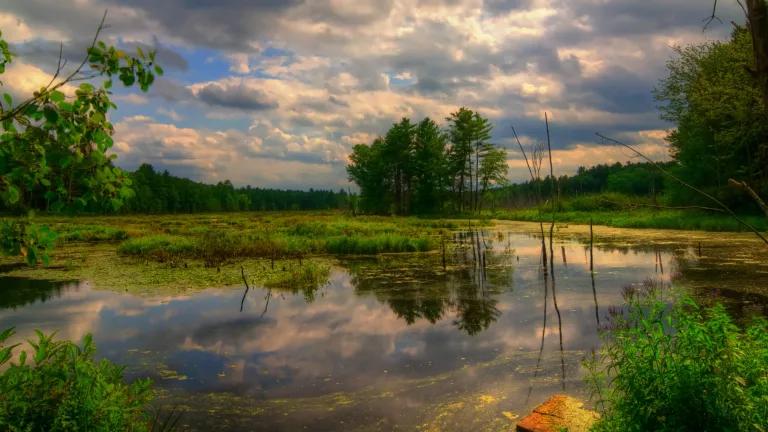NRDC at the World Wildlife Conference
NRDC is on the ground in Panama City, Panama, at the World Wildlife Conference—officially the 19th Conference of the Parties (COP19) to the Convention on International Trade in Endangered Species of Wild Fauna and Flora, or CITES.

NRDC at CITES CoP19
Read more about CITES and NRDC’s goals in Zak Smith’s blog.
Follow our live updates here.
23 November – 24 hours for reptiles, amphibians and some ambition at CITES
From Tuesday evening to Wednesday evening, the Parties to CITES turned away from the usual debates over charismatic mammals and took up important proposals related to snakes, turtles, frogs and lizards, all pretty charismatic themselves. These kinds of species are overlooked time and time again at CITES meetings, but Parties, especially the United States, brought them into the light at COP19. Here’s a summary.
A few species were transferred from Appendix I to Appendix II. While we worry that reducing protections for species is generally not appropriate given the larger context of the biodiversity crisis we face, in some cases the downlistings can signal an overall improvement in the conservation status of those species, if there are effective controls on trade to ensure they don’t decline in the future.
These included proposals to transfer the Brazilian population of the broad-snouted caiman, the Puerto Rican boa, and the Philippine population of saltwater crocodile in Palawan Island to Appendix II. However, a proposal to downlist the Thai population of the Siamese crocodile, which has not recovered and still faces threats from trade, was defeated.
Other App. II listings included the Jeypore Indian gecko; Chinese water dragon; Helmethead gecko; Horned lizards (21 species); Matamata turtles (2 species); Alligator and common snapping turtles (2 species); Map turtles (5 species); Neotropical wood turtles (9 species); red crowned roofed turtle; narrow-bridged, giant, Mexican, and five other species of musk turtles; mud turtles (20 species); and softshell turtles (3 species). Listing over 50 turtle species in Appendix II was a big step forward for CITES Parties.
A proposal to ban all commercial trade in pygmy bluetongue lizards, which proponent Australia said should be admired for “their supreme cuteness,” was accepted by consensus, as was a proposal by India to ban commercial trade in Leith's softshell turtle.
Tuesday night ended with a surprise. A proposal to list over 150 species of glass frogs on Appendix II was adopted by consensus despite opposition by the EU and some other countries. A similar proposal was defeated by only a couple of votes in 2019 at COP18. Glass frogs are prized as pets around the world and in Europe and the U.S. in particular.
Unfortunately, an effort by the U.S. to list the timber rattlesnake on App. II in order to understand the impact that trade is having on the species at a national scale was derailed by the EU and other parties, not to mention the Association of Fish and Wildlife Agencies (AFWA), which often opposes proposals by the US Fish and Wildlife service because of state concerns over federalism and state authority over wildlife.
The U.S. ultimately withdrew the proposal after some bizarre interventions by AFWA and some other U.S. pro-state and local rights organizations.
Several times, the EU either raised concerns about proposals or outright opposed proposals, so much so that it started to look isolated and out of touch with where Parties to CITES want to take the Treaty. For years, the conventional wisdom was that listing proposals, which must pass with a 2/3 majority, were at the mercy of the EU and its 27 votes.
But no more. Many of the proposals it opposed were adopted by consensus or by convincing vote margins even without the EU’s votes, thanks in large part to emerging voting blocks in Latin America, West Africa, and others raising their voices for ambition and asserting their collective power. During the debate on the neotropical wood turtles, the EU said it wouldn’t block consensus, acknowledging the “mood in the room” was in support. Hopefully the EU recognizes that the mood on the planet is for ambition to disrupt the status quo from now on.
- Paul Todd
21 November – Worry for rhinos, positive steps for songbirds
Southern white rhinos in Namibia, of which there are only about 1,200, were downlisted from Appendix I to Appendix II today at CITES COP19, with the support of such Parties as Mexico and organizations like World Wildlife Fund for Nature (WWF). Namibia won’t able to trade in rhino horn or other products, but it will now be allowed to export live white rhinos only to places in the species’ natural and historic range for conservation efforts.
But, with the Namibia population on Appendix II, a proposal to sell rhino horn products and trade in live rhinos is sure to follow at COP20 in a few years. Thankfully, a proposal to downlist white rhinos and trade in rhino horn and other products from Eswatini was defeated.
CITES Parties also listed two species of vanishing birds on the CITES Appendices today, both of which are highly sought after for the legal and illegal trade in songbirds. The White-rumped shama (Kittacincla malabarica), which is found in 15 countries but in increasingly small, fragmented populations, was listed on Appendix II so that exports for the caged songbirds trade can be regulated and monitored. Some island dwelling and other white-rumped shama subspecies are thought to be extinct already despite the species’ wide distribution. Malaysia and Singapore sponsored the proposal. Indonesia supported the proposal but asked to amend the proposal to include an 18-month delay in implementation, which was rejected.
Party after party expressed their belief that that the species clearly meets the criteria for listing on Appendix II and would benefit from CITES protection. Even Indonesia and China, which often oppose proposals to list native or regional species, highlighted the role that an App. II listing would play in helping ensure that the species did not continue to decline due to international trade.
Curiously, however, both the IUCN/TRAFFIC assessment of CITES proposals and the comments and recommendations on proposals by the CITES Secretariat recommended against the Appendix II listing. The IUCN Asian Songbird Specialist Group recognized the caged bird trade as the largest threat to the species, and Party after Party expressed their belief that the species was more or less perfect for Appendix II listing. It’s yet another instance of IUCN/TRAFFIC and the CITES Secretariat applying a different standard for proposals than Parties are using.
The United States joined Malaysia and Singapore in proposing a ban on commercial trade in another Southeast Asian songbird, the straw-headed bulbul (Pycnonotus zeylanicus), which has been decimated by trade and now numbers only around a thousand individuals, mostly living in the small island state of Singapore. The proposal was adopted by consensus, and with some decisions to further evaluate songbird species to identify others that may need to be protected under CITES in the future.
- Paul Todd
17 November – Painstakingly slow progress as CITES protects trees and sharks
The CITES Parties began considering proposals to amend the CITES Appendices today, although the progress was excruciatingly slow and plodding.
In the morning, the Parties spent hours discussing three proposals to add hundreds of tree species to CITES Appendix II: Cumaru (dipteryx), Trumpet Trees (Handroanthus, Roseodendron, and Tabebuia), and Pod mahoganies (Afzelia).
Fortunately, all passed overwhelmingly. Unfortunately, they were weakened before passage with amendments to delay their implementation for 24 months—almost the amount of time until the next CITES Conference of the Parties. We were also shocked that the U.S. voted “no” on all three proposals, despite that these species clearly meet the CITES criteria and desperately need help.
About 30 percent of assessed tree species are endangered, according to the Global Tree Assessment, and that number will only increase as more tree species are assessed. Today’s listing was a positive step towards making up some ground for trees and the forests they create.
Also, despite vehement opposition from commercial fishing interests, the Parties to CITES listed over 50 species of requiem sharks and 6 more species of hammerhead sharks on Appendix II, which means trade in those species will be regulated and subject to trade controls. Most of the species are in decline in large part because of the global trade in shark fins, which has devasted shark populations around the world.
Listing all hammerhead and requiem sharks under CITES Appendix II is major step for global shark conservation, improving international management of sharks by bringing the vast majority of species in the global fin trade under CITES Appendix II protections.
Host country Panama, an advocate for increased ambition at CITES, was the chief sponsor of the proposal to list requiem sharks on Appendix II. Panama has noted that some of the species in the proposal actually qualified for App. I, which bans on all commercial trade in species. Sri Lanka highlighted that there are two species in the proposal that are thought to be extinct already.
Listing commercially valuable fish species like sharks under CITES is incredibly difficult, however, given the powerful interests that support unsustainable harvest of marine resources around the world. Listing on App. II is often the only viable option even for critically endangered shark species that should not be harvested at all. Three of the 6 species listed today are classified as critically endangered on the IUCN Red List of Threatened Species.
An amendment to remove 35 of the more than 50 species included in the requiem shark proposal was defeated, though an amendment delaying implementation of the listing for 24 months was adopted. The U.S., though ultimately voting in favor of the proposal, supported an amendment to remove blue sharks from the listing. Blue sharks are the world’s most traded shark species and account for about 70% of the shark fin trade. The U.S. supported the hammerheads proposal, and it was adopted by consensus.
The direct exploitation of species is the number one driver of biodiversity loss in the world’s oceans, causing more species to decline than sea use changes, climate change, pollution, and other threats. The CITES Parties are doing well to get all sharks listed on App. II so that trade can be regulated. But we need to see a lot more proposals like this—ones that are broad and cover a large number of species including look-alikes. But it’s also increasingly likely that many shark species will disappear forever before the Parties to CITES can do what is truly necessary to avoid extinction and recover global shark populations.
- Elly Pepper and Paul Todd
16 November – CITES examines tree declines from trade; fails to increase trade protections for any species so far
As Day 3 of CITES comes to a close, I can't help but reflect on the fact that the Parties have yet to increase protections from trade for a single species.
Today the discussion finally turned to trees, many species of which are traded internationally (for lumber, etc.) and are, therefore, regulated by CITES. Unfortunately, CITES isn't doing a good enough job protecting trees, which are a key defense against both biodiversity loss and climate change. Of the 60,000 known tree species, nearly 46,000 (77%) have conservation assessments and at least 30% of all tree species (~17,500) are threatened with extinction globally. But fewer than 1,000 tree species are protected under CITES. Only seven tree species are listed in Appendix I--the CITES category that provides the highest level of protection from trade. And no new species has been included in Appendix I since 2003, when the monkey puzzle tree (Araucaria araucana) was uplisted from Appendix II.
Fortunately, the situation is improving with the Parties adding entire genera of tree species to CITES in the past several years, including the Dalbergia spp. and Cedrela spp. At this meeting, there are five Appendix II listing proposals for trees that, if passed, would increase trade protections for about 150 tree species. We must systematically identify tree species that meet the criteria for listing and get them listed quickly. If we trade our tree species to extinction, we will not be able to address the biodiversity or climate crises and our planet will be lost.
Finally, NRDC and our partners at Center for Biological Diversity, Animal Welfare Institute, and the Department of the Interior educated Parties on the plight of the vaquita, a porpoise species which has been reduced to ten individuals due to illegal fishing for totoaba. Vaquita are drowned in illegal gillnets used to catch totoaba, whose swim bladders are prized in many Asian countries as a delicacy. Where would this species be if Parties had actually utilized sanctions years ago and sanctioned Mexico for allowing this? Not only must CITES step up action to save this species, but it must also never allow this to happen again. This is a cautionary tale and if CITES Parties continue to treat species like they've treated the vaquita -- not doing anything until there's only 10 left -- our planet's wildlife is lost.
- Elly Pepper
15 November – CITES looks at its role in the biodiversity crisis
For the first time, leading countries proposed various mechanisms and tools to increase ambition and disrupt the global exploitation of species, which is a top driver of the biodiversity and climate crisis gripping our planet, at the CITES 19th Conference of the Parties in Panama City, Panama. Other countries, most notably the European Union, which is often touted as a conservation leader, blocked consensus, and urged rejection of the proposal, which was ultimately tabled for a decision later in the meeting.
Nigeria and five other West African nations called for the development of a database listing the estimated hundreds or thousands of threatened species that are not protected under the CITES treaty but are falling prey to unsustainable legal and illegal wildlife trade. The proponents also called for a procedure to assist developing countries with the production of proposals to list plants and animals on CITES appendices and ban or regulate trade in those species.
Unfortunately, the proposal caused some fear and retrenchment into status quo ways of thinking from among influential Parties to the CITES treaty and even the CITES Secretariat. The EU and others urged outright rejection of the proposal, arguing that the IUCN Red List of Threatened Species was sufficient to identify species in need of protection, the Convention needed to focus on already-listed species, and that resources were available to assist developing countries of only they take the initiative to ask. The UK and the U.S. offered to work with the proponents from West Africa on an alternative proposal, which will come back before the Parties later this week.
We know from the 2019 IPBES Global Assessment Report that there are about a million species threatened with extinction over the next decades and we know that many of these species are declining because of wildlife trade, legal or illegal. We also know that many of these species are not protected by CITES. Most have never been discussed at meetings of the Conference of the Parties, all the while the biodiversity crisis continues.
Dialogue continued into the evening, however. NRDC and partners supported Nigeria, Panama, and the U.S. as they hosted a side event titled “Meeting the Moment: CITES and the Biodiversity Crisis.” Sir Robert Watson, former chair of both IBPES and the Intergovernmental Panel on Climate Change (IPCC), outlined the crisis and the need for transformative change, including in the ways we harvest and use wild species, and Professors David Wilcove and Eyal Frank summarized their study of the lags in both the number of qualified species that are listed on the CITES Appendices and the decade it takes for CITES to protect newly-endangered species.
Countries like Nigeria, Panama, and the U.S. are already leading efforts to join together and fight climate change and biodiversity loss. Perhaps a new coalition to take trade off the table as a threat to the world’s wildlife is in order, and CITES is the place to do it.
-Paul Todd
14 November – The World Wildlife Conference begins; tensions flare over voting rules
The "World Wildlife Conference" (which should actually be called the "World Wildlife Trade Conference" because harmful trade in wildlife is it's only focus) opened with inspiring speeches and statements from the host country Panama, the CITES Secretary-General Ivonne Higuero, and other dignitaries. To the person, speakers highlighted the global biodiversity crisis and the need for greater ambition and renewed commitment to addressing the biodiversity crisis.
And then the business of the convention started and things got immediately heated. Parties discussed a proposal from Botswana and Zimbabwe to apportion voting rights on species proposals based on "the population size of the species under discussion or whose status is subject to voting. Parties with larger populations shall be allocated more votes in comparison with Parties with smaller populations using a formula to be decided by the CoP." Species proposals largely deal with the placement of species on the CITES Appendices, which is CITES's core trigger for species conservation actions.
The proposal was a non starter from the beginning as most Parties were not interested in having their voting power diminished based on species population sizes. Nonetheless, it highlighted a tension within the Convention. Many pro-use governments, like those in power within Botswana and Zimbabwe, do not like the control the Parties have over decisions related to international trade in their wildlife, such as elephants. With larger populations of elephants, they'd like to have greater power over the international trade regimes applicable to elephant ivory. The vast majority of Parties disagreed, wanting to maintain equal voting rights when making decisions about how international trade will impact a particular species, like elephants.
- Zak Smith
8 November – CITES and the global biodiversity crisis
The Convention on the International Trade in Endangered Species of Wild Fauna and Flora (CITES) was drafted almost 50 years ago, and to date 183 countries have ratified the treaty. CITES is credited with saving hundreds of species that might have gone extinct because of rampant, uncontrolled trade in things like elephant ivory, rhino horn, tiger skins, medicinal plants, exotic hardwoods, tortoise shell and countless other products.
The treaty bans international commercial trade in species that are "threatened with extinction" and "are or may be affected by trade," and limits trade in other species that are not yet threatened with extinction, but "may become so unless trade in specimens of such species is subject to strict regulation."
Despite its success at staving off extinctions, however, CITES has had no success in accomplishing its goal of ensuring that the international trade in wild species does not threaten their survival. In fact, the direct exploitation of organisms, which includes global wildlife trade, is a leading driver of the global biodiversity crisis currently gripping our planet - it’s the leading cause of marine species loss and second leading cause of terrestrial species loss, according to a 2019 landmark global assessment on the status of global biodiversity.
Given the myriad threats they face, the planet's wild species can no longer withstand the current "business-as-usual" approach to wildlife exploitation taken by many Parties to CITES and important stakeholders like the International Union for the Conservation of Nature (IUCN) and the CITES Secretariat, among others. Thankfully, bold leaders from among the Parties and forward-looking partners see CoP19 as an opportunity - perhaps our last - to place CITES on a path fit for the next 50 years, one focused on ambitious, creative, and effective action to halt extinction and recovery threatened species.
NRDC will be highlighting those leaders that are meeting the moment, as well as calling out Parties and other actors who block ambitious decision-making during the course of the meeting.
- Paul Todd




